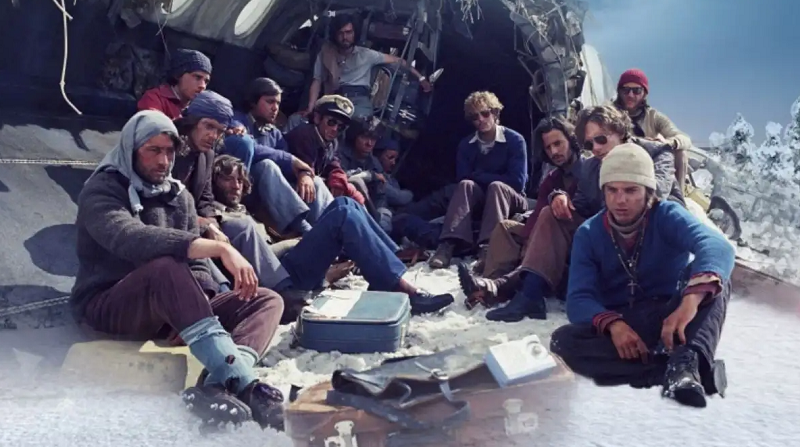
In the wake of the tragic 1972 Andes plane crash, survivors faced an arduous 72-day struggle in freezing conditions and resorted to desperate measures for survival, including cannibalism. Their incredible story, portrayed in the film “Society of the Snow,” serves as a testament to human resilience, survival instincts, and eventual rescue.
The Andes Plane Crash
The Andes Plane Crash of 1972 involved Uruguayan Air Force Flight 571, a Fairchild FH-227D, on a route from Montevideo to Santiago. Piloted by Lieutenant-Colonel Dante Héctor Lagurara, the plane made a critical navigational error, leading to an unintended descent towards Santiago. Colliding with a mountain ridge, the aircraft lost its wings and tail before sliding down a glacier. The crash resulted in immediate fatalities, and subsequent deaths occurred due to the harsh environment. Survivors, including members of the Old Christians Club rugby team, faced unimaginable hardships and ultimately had to resort to cannibalism for sustenance.
Over the course of 72 grueling days, they battled extreme cold, hunger, and avalanches. Notably, two survivors, Nando Parrado and Roberto Canessa, embarked on a perilous 10-day journey to Chile in search of help. Their rescue on December 23, 1972, marked the end of an extraordinary tale of survival. The crash was attributed to controlled flight into terrain due to pilot error. The fuselage came to rest in a remote glacier, bearing witness to the indomitable human spirit in the face of the harshest circumstances.
What Happened to the Survivors of the Andes Plane Crash?
The survivors of the Andes plane crash, which occurred on October 13, 1972, endured a harrowing 72-day ordeal in the frigid Andes mountains following the crash of Uruguayan Air Force Flight 571. Out of the 45 passengers, 29 lost their lives initially, leaving behind 33 survivors.
Only 16 of them ultimately persevered through the brutal conditions, injuries, and a devastating avalanche. Stranded in the wilderness, they were forced to resort to the unthinkable act of consuming the flesh of their deceased fellow passengers for sustenance. The remarkable story of these survivors served as the inspiration for the Netflix film “Society of the Snow,” based on Pablo Vierci’s book. Dr. Roberto Canessa, one of the survivors, bravely shared his memories, recounting the fear of imminent death and the difficult experience of watching a film that depicted the grim details with accuracy.
Despite the tragedy, Canessa and his teammate Nando Parrado embarked on an arduous trek to seek help, leading to their miraculous rescue on December 22, 1972. Today, Dr. Roberto Canessa is a renowned pediatric cardiologist who reflects on the lessons learned from the tragedy as a testament to overcoming life’s challenges and maintaining unwavering self-belief.
Where Are the Andes Plane Crash Survivors Now?
As of the present day, 14 out of the 16 survivors of the Andes plane crash are still alive. José Luis “Coche” Inciarte and Javier Methol passed away in 2023 and 2015, respectively, while Sergio Catalan, who encountered survivors after their trek, sadly, passed away in 2020. Several of the survivors, once leading private lives, have gone on to become authors and motivational speakers.
Dr. Roberto Canessa, now 70 years old, authored the book “I Had to Survive,” and Fernando Parrado, who transformed into a motivational speaker, penned “Miracle of the Andes.” Other survivors like Carlitos Páez and Inciarte have also shared their experiences through books.
Updates from Pablo Vierci’s book reveal diverse paths taken by the survivors. Eduardo Stauch became an architect, Pancho Delgado opened a law firm, Gustavo Zerbino now leads the Uruguayan Rugby Federation and works in pharmaceuticals, and Tintín Vizintín has become the president of the Uruguayan Rugby Union. These post-tragedy journeys exemplify resilience, success, and diverse contributions to society.
The Extreme Temperatures Faced by the Survivors
The survivors of the Andes Plane Crash confronted brutal temperatures in the unforgiving Andes Mountains. Exposed to the elements, they endured outdoor temperatures plummeting to approximately 30°C below zero. The extreme cold, coupled with high altitude and the lack of shelter, created a nightmarish scenario.
During their 72-day ordeal, the survivors grappled with the challenges of coping with corpses, panic, disorientation, and physical pain while enduring these harsh conditions. The human body, when subjected to such cold, exhibited remarkable adaptations to preserve vital organs by constricting blood vessels in extremities.
In this life-and-death struggle, they not only had to navigate the aftermath of a plane crash but also battle hypothermia, which induced muscle contractions and tremors. The vivid portrayal of their ordeal in the Netflix series sheds light on the extraordinary resilience required to endure temperatures that could lead to unconsciousness and death within minutes.
The Annual Reunion of Survivors
The survivors of the Andes Plane Crash, as depicted in the book “Society of the Snow,” which inspired the Netflix movie, gather annually on December 22. This date holds significant meaning as it marks the first day of their miraculous rescue and has become a time for a heartfelt ritual commemoration.
During these poignant gatherings, the survivors reunite with their families, bearing witness to the growth of the next generation. Many of their children, now aged between 18 and 26, are the same age as their parents were during the traumatic mountain ordeal.
Dr. Roberto Canessa, a survivor, has created a special meeting place in his house, emphasizing the enduring bond among the group. The shared experiences of the survivors, as depicted in the movie “Society of the Snow,” continue to forge a powerful connection, fostering applause, embraces, and tears during their annual reunions.
What Happened to the Survivors of the Andes Plane Crash – FAQs
1. What caused the Andes Plane Crash in 1972? The crash was caused by controlled flight into terrain due to pilot error.
2. How did the survivors endure extreme temperatures during the 72-day ordeal? The survivors faced temperatures around 30°C below zero by adapting to the cold, constricting blood vessels, and battling hypothermia.
3. Where do the survivors gather each year, and why? The survivors gather annually on December 22 to commemorate the first day of their rescue, reuniting with families and reflecting on their shared experiences.
4. How many survivors are still alive from the Andes Plane Crash? As of now, 14 out of the 16 survivors are still alive.
5. What significant actions did Dr. Roberto Canessa take post-rescue? Dr. Roberto Canessa, one of the survivors, became a renowned pediatric cardiologist and authored the book “I Had to Survive,” reflecting on the lessons learned from the tragedy.



